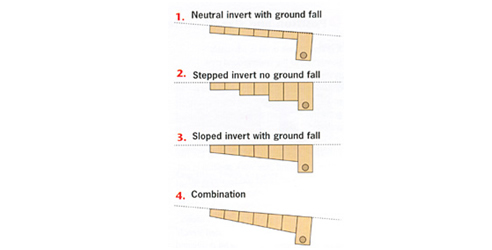Trench Drain Slope and Hydraulic Performance from ACO How slope of a Trench Drain Affects Hydraulic Performance If there's one thing that drives the design of ACO's market-leading trench drain systems, its hydraulic performance. Poorly designed drainage runs are not only ineffective at clearing rainwater quickly, but they are difficult to maintain and can cause slip hazards from ponding. On top of these hazards, poorly designed drainage runs can affect the aesthetic quality of the pavement in which it is placed, and can be unnecessarily costly. So, how do we achieve optimum hydraulic efficiency? We design a variety of drains and grates for various applications, but when it comes to clearing surface water, the job inevitably depends on how trench drains are configured. These systems collect and remove surface liquid through modular channels, to be carried to a point where it can discharge into an underground pipe system or culvert. One key factor influencing the hydraulic performance of trench drain systems is gravity and how it complements natural or artificial falls in the pavement.. How does the slope affect hydraulic performance? Because the level of grading (or the slope) of the invert increases the velocity of the liquid within the trench drain, it plays a pivotal role in the hydraulic efficiency of the drain. The slope can be introduced into the design of the drain by one or a combination of the following:
- Existing pavement with natural fall
|
1300 765 226 Emu Plains, NSW, 2750
|




 Sloped Trench Drains for Sports
Sloped Trench Drains for Sports Heelsafe Anti-slip Grates and Covers
Heelsafe Anti-slip Grates and Covers Balcony Drains for Sydney Apartments
Balcony Drains for Sydney Apartments Bridge Stormwater Drainage with
Bridge Stormwater Drainage with Custom Sloped Channel Drainage for Pools
Custom Sloped Channel Drainage for Pools Slip-Resistant Push-Fit Drainage for
Slip-Resistant Push-Fit Drainage for Grease Management and Drainage for
Grease Management and Drainage for Freestyle Architectural Drain Grates -
Freestyle Architectural Drain Grates - Surface Water & Cable Management of Rail
Surface Water & Cable Management of Rail KerbDrain Trench Drain System for Camden
KerbDrain Trench Drain System for Camden Trench Drain Shape and Hydraulic
Trench Drain Shape and Hydraulic Multipart Access Cover Installation
Multipart Access Cover Installation Drainage for Road Infrastructure by ACO
Drainage for Road Infrastructure by ACO Steel Production for Construction Across
Steel Production for Construction Across Surface Drainage for Construction by ACO
Surface Drainage for Construction by ACO Non-Slip Drainage for Public Area from
Non-Slip Drainage for Public Area from Hygienic Grease Management for
Hygienic Grease Management for Grease Management and Drainage System
Grease Management and Drainage System Trench Drains for Transport
Trench Drains for Transport New Trench Drain Technical Handbook by
New Trench Drain Technical Handbook by
